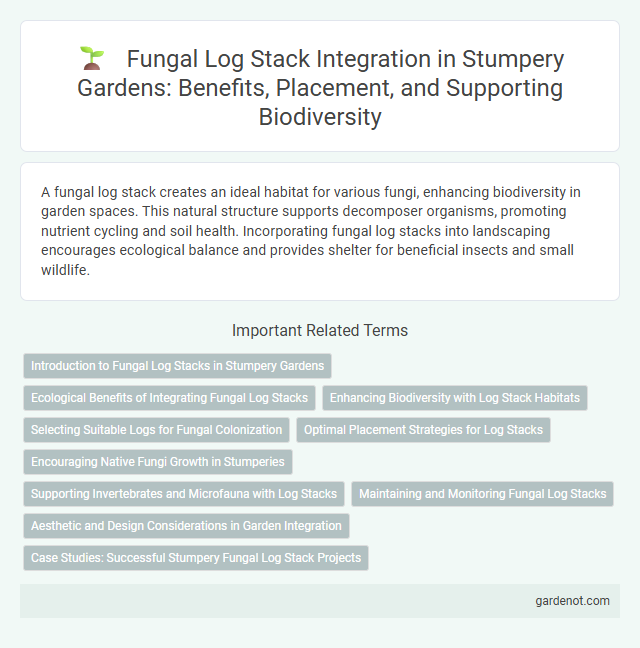A fungal log stack creates an ideal habitat for various fungi, enhancing biodiversity in garden spaces. This natural structure supports decomposer organisms, promoting nutrient cycling and soil health. Incorporating fungal log stacks into landscaping encourages ecological balance and provides shelter for beneficial insects and small wildlife.
Introduction to Fungal Log Stacks in Stumpery Gardens
Fungal log stacks are essential elements in stumpery gardens, providing a natural habitat for diverse fungi species while enhancing woodland aesthetics. These stacks promote fungal growth by maintaining moisture and offering decaying wood, which supports ecosystem health and biodiversity. Incorporating fungal log stacks encourages decomposer activity that enriches soil nutrients and fosters plant development in shaded garden areas.
Ecological Benefits of Integrating Fungal Log Stacks
Fungal log stacks enhance soil health by facilitating mycelium growth, which improves nutrient cycling and promotes beneficial microbial activity. They create habitats for fungi that break down organic matter, accelerating decomposition and enriching forest ecosystems. Integrating fungal log stacks supports biodiversity and aids carbon sequestration, contributing to ecosystem resilience.
Enhancing Biodiversity with Log Stack Habitats
Fungal log stacks create essential habitats that boost local biodiversity by providing shelter and nutrients for various fungi, insects, and microorganisms. These decomposing logs support complex ecological interactions, promoting soil health and forest regeneration. Integrating fungal log stacks into garden designs encourages a thriving ecosystem by mimicking natural habitats and sustaining diverse species populations.
Selecting Suitable Logs for Fungal Colonization
Choosing hardwood logs such as oak, beech, or maple is essential for successful fungal colonization in a stumpery due to their dense composition and slow decay rate. Logs should be freshly cut, free from chemicals, and preferably sourced from disease-free trees to encourage robust mycelium growth. Ensuring the logs retain adequate moisture and are positioned in shaded, humid environments enhances fungal spore germination and proliferation.
Optimal Placement Strategies for Log Stacks
Fungal log stacks in a stumpery thrive best when placed in shaded, moist environments that mimic natural forest floor conditions. Positioning logs on well-drained soil with partial sunlight maximizes fungal colonization and diversity. Avoid direct exposure to harsh weather to maintain optimal humidity levels crucial for successful fungal growth.
Encouraging Native Fungi Growth in Stumperies
Fungal log stacks in stumperies create ideal microhabitats that encourage the growth of native fungi species by maintaining moisture and providing decaying wood as a nutrient source. These stacks support biodiversity by fostering mycorrhizal networks essential for forest health and nutrient cycling. Incorporating diverse wood types in fungal log stacks enhances colonization by a variety of native fungi, promoting ecological balance within garden ecosystems.
Supporting Invertebrates and Microfauna with Log Stacks
Fungal log stacks create moist, sheltered habitats essential for supporting diverse invertebrates and microfauna by providing food sources like decaying wood and fungi. These log stacks enhance biodiversity by offering breeding grounds and safe refuges for beetles, woodlice, and springtails. Integrating fungal logs into garden stumperies fosters ecological balance through natural decomposition processes that sustain soil health.
Maintaining and Monitoring Fungal Log Stacks
Maintaining fungal log stacks involves regularly checking moisture levels to ensure optimal conditions for mushroom growth, typically keeping logs damp but not waterlogged to prevent rot. Monitoring for signs of contamination such as mold or insects requires prompt removal of affected logs to protect the health of the fungal colony. Periodic rotation of logs and replenishment of fresh wood further support sustained fungal development and biodiversity within the stumpery.
Aesthetic and Design Considerations in Garden Integration
A fungal log stack enhances garden aesthetics by creating a naturalistic focal point that mimics woodland environments, blending seamlessly with native flora and moss. Careful placement in shaded, moist areas supports fungal growth while adding textural contrast and architectural interest to garden design. Incorporating diverse log sizes and decay stages enriches biodiversity and visual complexity, promoting both ecological health and artistic appeal.
Case Studies: Successful Stumpery Fungal Log Stack Projects
Case studies of successful stumpery fungal log stack projects demonstrate how integrating diverse fungal species enhances biodiversity and soil health in garden ecosystems. Projects such as the New Forest Stumpery showcase how strategic log placement promotes natural fungal colonization, resulting in robust mycelial networks that improve nutrient cycling and support native plant growth. These case studies emphasize the importance of selecting appropriate wood types and moisture conditions to optimize fungal development and ecological benefits.
Fungal log stack Infographic

 gardenot.com
gardenot.com